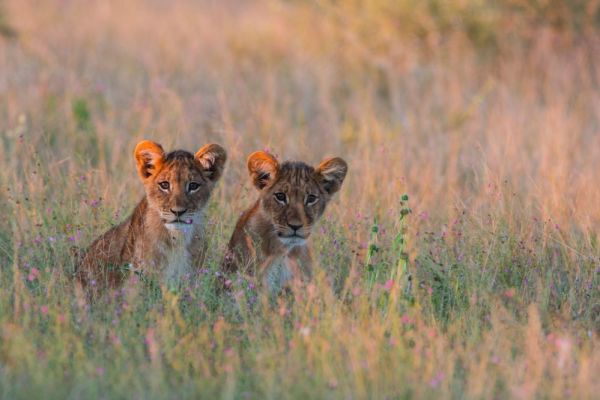BotswanaTravel Guide
From one of the world’s great wetlands, the Okavango Delta, to Big Five game reserves and luxury lodges, Botswana beckons those looking for an African bush experience of a lifetime. A place where big cats roam, herds of elephants patrol the lands and wildlife drink and laze about in the Chobe River, this premier safari destination has everything and a bit more.
While an upmarket game lodge may sound enticing, staying in a tented camp brings you closer to a real Out of Africa experience, where you can fall asleep to the sound of lions roaring in the night, and hippos snuffling on the riverbanks.
Drift out on the river in a traditional mokoro (dug-out canoe) and be amazed by the abundant and colourful birdlife in the reeds or spend the day on a game drive in the Chobe National Park or the vast Central Kalahari Game Reserve with its wide, white pans – once the stomping ground of the ancient San people. But where to start? If you’re new to safaris, fear not. This Botswana travel guide has all the information you need.
Botswana quick facts
Language
National language
English
Beverages
Bottle of Coke/Pepsi (330ml)
CAD $1.06
Local time
Sunday
7:18pm
Currency
Botswana pula
CAD $1.00 = BWP P10.03
Eating out
Restaurant meal (casual dining)
CAD $8.46
Electricity
Plug type: D
3 pins • 230V
Explore Botswana
Where to stay in Botswana?
Unsure about where to stay in Botswana? From luxury lodges to tented camps and everything in between, here are a few of our favourites worth considering:
Elephant Sands is a mecca for elephant lovers. Witness them in their dozens enjoying a refreshing drink at the natural waterhole in front of the lodge. Occasionally they might even have a preference for the pool! Aside from the ellies, this relaxed accommodation also boasts a prime location at the centre of Botswana’s highlights: the Makgadikgadi Pan, Okavango Delta and Chobe National Park.
Consisting of Meru-style canvas tents, Bushman Plains may seem a little simple, but there’s no better place to unlock the magic of the Delta. Take your pick from guided game drives and soul-stirring bush walks where you can move with the pace of nature alongside an expert San tracker. As a mobile tented camp, Bushman Plains also shifts location according to the time of year.
Should you have a bit more room in your budget for your Botswana safari, snap up a few nights at Tau Pan. Located on the ridge of a sand dune in Central Kalahari Game Reserve, this comfortable eco-camp offers a front-row seat to the limitless plains of the ‘Great Thirstland’. A top-notch spot to stargaze, and engage with the San people.
Believe us when we say, this is just the start. Book your Botswana accommodation today!
Things to do in Botswana
Many things to do in Botswana centre around wildlife and nature, as you might expect. A safari hotspot, you might need help deciding where to start. Here’s what we suggest:
No visit to Botswana would be complete without a trip to the Chobe National Park, a Big Five reserve in the northern part of the country. And if you have a soft spot for ellies make it your first stop. This region boasts one of the largest concentrations of elephants in Southern Africa. Guided game drives and Chobe River boat cruises allow you to get even closer to these impressive pachyderms. Until you’ve seen an ellie swim you will never believe that they can - and gracefully too. The park and the river are also home to zebra, buffalo, wild dogs and a wide variety of buck.
Just south of the Okavango Delta lies the Makgadikgadi Pan, between Maun and Francistown, a gigantic salt flat (once an ancient lake) that stretches out to roughly 12,000 square kilometres. It attracts many kinds of wildlife like zebra and wildebeest, who love nothing more than enjoying these natural salt licks. Turn your gaze skywards at night, and you’ll quickly understand why it’s worth the hype, blanketed with stars.
The Chobe National Park borders on Botswana’s Okavango Delta which needs little to no introduction. A UNESCO World Heritage Site (just like the Chobe), this wetland is filled to the brim with endemic water birds and other safari specials like red lechwes (antelopes). The best way to experience it all? By quietly meandering through the glistening channels on a mokoro.
This game reserve is the second-largest conservation area in the world and Botswana’s biggest, slap bang in the middle of the Kalahari Desert. For an immersive cultural experience, venture into the heart of this remote place that’s home to the Basarwa (San) people. Indigenous to Southern Africa, these hunter-gathers have skilfully navigated this region for well over 20,000 years. Some tour operators offer the experience of a bush walk with a San guide.
Looking for an immersive experience? Then a Botswana tour is the way to go.
Flights to Botswana
Botswana food and drink
Curious about where to eat in Botswana? Your lodge or tented camp will have this part perfectly sorted, but here are some ideas to whet your appetite:
This owner-run boutique restaurant and working farm is located on the cusp of the Okavango Delta. The coffee is first class, while the cuisine is hearty and varied. Insider’s tip: try to time your visit for Sunday breakfast, and don’t forget to add that special ‘Tshili’ sauce! It’s also easily accessible as a roadside lunch pit stop, being just 40 minutes’ drive from Maun Airport.
As you can tell, Botswanan’s love their meaty fare. Should you like to try a few local dishes in an upmarket setting, the Beef Baron Grill in Gaborone does this particularly well. Bookmark it as a spot to sample seswaa (stewed cow or goat meat), the country’s national dish.
If you want to tuck into the best ribs in Botswana, this pub-style restaurant in Gaborone is the place to go. The wood-fired pizzas will also hit the spot, and there’s cold beer on tap. If you’re travelling with kids, they’ll love the dedicated play area. But should you be in the mood to cut a rug, hang on for the live music after sunset.
Get a real taste for the local cuisine by booking a Botswana tour.
Botswana through your eyes
Where to shop in Botswana?
Since every major town and city in the country is kitted out with markets, shopping malls, and a signature African Mall, shopping in Botswana is easy. In terms of gift stores for souvenirs, most lodges will have their own curio shops with items sourced from communities in the area.
If you have some time to spare during your stay in Gaborone, Lentswe-la-Oodi is well worth a visit should you be in the market for handmade woven art (tapestries and baskets). Since this co-operative is led by and directly supports local women, each purchase you make goes directly towards a good cause.
Kill some time in Kasane browsing the stalls at the main market at Hunter’s Mall. You can pick up just about anything here, from roasted nuts to African cloth and dried mopane worms. Since there is no fence separating Kasane from Chobe National Park, animals move freely into the area. Don’t be surprised should you find yourself browsing alongside a warthog or two!
Maun offers plenty of stalls and local sellers punting anything from fresh fruit and veggies to mopane worms (chubby edible caterpillars), woven baskets, and shweshwe fabric. The main market is located on Tsaro Street, opposite the Shoprite. Maun Farmers Market also kicks off on the last Sunday of every month at Motsana from 9am to 12pm.
When is the best time to travel to Botswana?
Wondering about the best time to travel in Botswana? Here’s what to expect at different times of the year.
In Botswana, each season has its own unique charms and experiences. One person’s favourite time of year might be someone else’s worst. But generally speaking, the best time to travel to Botswana is during the dry season (winter) from May to September when there is plenty of sunshine, and game viewing reaches its pinnacle.
Interestingly, during this season in the Okavango Delta the water level increases, making it optimal for mokoro excursions. Should you like to explore the Central Kalahari Game Reserve, just be mindful of the rising temperatures there between September and October.
If you don’t mind donning a raincoat, the rainy season or green season, from January to March also hits the sweet spot. During this time of year, the bush is luscious and green, and it’s also birthing season. There’s nothing like seeing a baby antelope (African Bambi!) to help keep your mind off the weather.
On a budget? During the two annual shoulder seasons between April and May and October and November, many camps and lodges slash their rates. If you’re willing to embrace the element of unpredictability, these months prove a good time to go. And if you choose your location carefully, the game viewing will still be superb.
Don't miss out. Book your Botswana flight today!
How to get around Botswana
To help kick-start your travel planning, here’s everything there is to know about getting around in Botswana:
With tarmac routes between major towns and cities, driving in Botswana is relatively easy. In general, road conditions are adequate for 2WD, however, the wilder and more remote areas will require a high-clearance vehicle and will take longer to navigate. A 4WD comes highly recommended, especially during the wet season.
Botswana also features a local coach bus network linking the major towns. This service is operated by multiple private companies. As for getting around within urban areas, VW minibus taxis are the way to go.
Flying isn’t cheap but is the most reliable way to travel longer distances in Botswana. Most travellers opt to go by charter plane, especially when accessing more remote lodges and tented camps. It’s also the only way to reach the heart of the Okavango Delta.
Air Botswana (the national carrier) also links the safari gateway of Maun, along with Kasane, Gaborone, Windhoek in Namibia and Johannesburg in South Africa.
Let us help you organise your own wheels for exploring. Hire a car in Botswana today!










